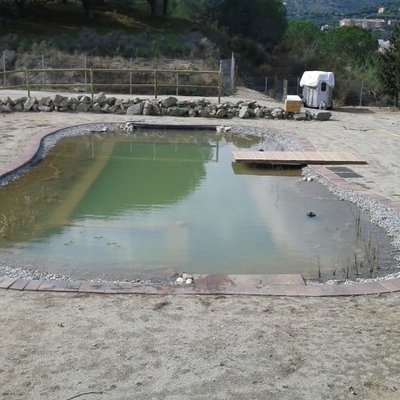
We use cookies from thirth parties to inprove your experience and our services. If you do not close this window we understand that you allow its use. For more information about cookies click here
Cerrar


 | Download article | Times downloaded:
691
| Download article | Times downloaded:
691
The flexible gabion consists on barriers formed by joined partitions so that the barrier entirely works against an effort. It is a light barrier, around 9 kg for a 9-meters length and 1-meter height-barrier of flexible gabion for a 1’00 m of wall thickness. The material is composed of two geosynthetic layers, polyethylene type, of a high density and resistance with an impermeable inside.
The flexible gabions work through gravity, as a traditional wire gabion, but it departs significantly. They are bottom-opened so that the soils connect in a natural manner, being the ground integrated among the layers. The final compaction is naturally achieved through water, wind, temperature etc. Moreover, they can be joined by corrugated steel bars, improving the slipping safety and it achieves a certain degree of flexion in case of accident. The gravity weight makes its calculation but all the specifications stated above are clear added advantages.

Indeed, the flexible gabions are mainly thought to be used together with materials from the same ground where it is placed. Nevertheless, they can be also be filled with artificial aggregates, a mixture of cements and gravel as pretending to be gravel-cement material. They can be also filled in with other binders, lime, graves etc. but they will act as a normal gabion and the natural auto-compaction possibility will be lost.
The length of the barriers can be also joined, if desired, through the incorporated hinges, located at both ends, where a corrugated bar is introduced for both barriers to be connected. This is also important as they are hold also by each other when facing an external action. This does not happen with the traditional gabion as the fixing is made, in mostly cases, through simple wire. In addition, if desired, their height can also be united through separated steel bars and, with the passing of time, even with roots or plants grown. Regarding the rest of the floats, they should be impermeabilized with EPDM sheets, polyethylene or other.

Reservoirs made by Contflexdique flexible gabions
The flexible gabions barriers can be applied to a varied range of situations. Everything that can be solved by a wall, in many cases, even substituting or collaborating with the reinforced concrete is used in a provisional or a permanent form. It is a sustainable work, ecologic, recyclable and it does not generate waste.
The system easily adapts to the ground and absorbs any deformation as it is not composed by a rigid material. It is useful against earthquakes or ground movements. As in any other, the correspondent constructive solutions will be applied (drainages etc)
It is also useful in emergencies as anti-flooding barrier, as a protection barrier against landslides, in motorways curves, as a protection against explosions etc.
These walls can be vegetated or their exterior can be lined, if desired, using any other material (stone, brick, traditional gabion etc.) so the flexible gabion is the one acting as a support and the external one is decorating.
The flexible barriers can be curved or they can form corners etc. It is just a matter of collecting and holding the desired measure of the modules composing the barrier.

Walls made by Contflexdique flexible gabions aimed to form a swimming pool, a tank or others
One of the advantages at a work situation is that the machine fills the flexible gabions, so the working efficiency is high and the final cost is highly reduced compared to traditional systems. Furthermore, the performing times are also reduced. In order to hold the barrier, corrugated bars are used, scrolling as the barrier is being filled. In case of a big length a removable frame is used, advancing as the gabion is being filled.
Regarding the ravines, they could act as a filler, using the same natural sediment material from the water. They are also useful for the settlement of gullies, being crossed and making them being filled in a natural manner until the water is laminated on the superior part without important works.

Forest road reparation due to ravine’s rushing waters
Another possible application is as a holding of way laterals against rushing waters. As it was already explained, the uses are varied and they depend on the engineer, architect or technic’s ingenuity or projection.
They are also suitable at the beaches against storms, the high tide of the sea etc. In these cases, a trench is made in front of the wall to be protected (in EDAR or EBAR caskets, at the close building foundations, garages at the beach, buried structures etc.) The flexible gabion barrier is introduced and, in many occasions, it will be even filled with the beach sand itself, obtaining an overprotective wall and avoiding the building wall deterioration.

Example of beach reparation
Another urban application is the ground holding of parcel boundaries when they are at a lower level than a surrounding street. It is not necessary a concrete wall if it is not built and it is expected to be used as a support. The work cost is inferior than the one from a reinforced concrete wall. The flexible gabion wall could be vegetated and it will provide a gracious appearance.
ADVANTAGES, CHARACTERISTICS AND USES
Lightness: it is versatile, manageable and easily transportable. It does not have a high cost as the low weight makes it transportable thousands of Contflexdique line meters with a low cost.
Easily used: its simplicity provokes a rapid installation, avoiding many costs. At least the manually cost. It is easy to be filled using machinery.
Economic: the cost of the filling material is economic as in many cases the ground from the setting place itself is used. Conglomerates can also be used, mixed with soils (concrete, lime, etc), if an earlier resistance of the filling material is desired.
Adaptable: the barriers are adapted to the ground as they can be covered by soils and plantation is possible. Due to the thickness of the wall no foundation is needed. It is also useful against earthquakes due to its elastic property. If a removal is desired, it is easily achieved and little waste production will be generated.
USES:
Reservoirs or floats, holding slops, expansion of property’ s entrances, water regulation in ravines, forestall ways reparation, military fortification, dam constructions, anti-flooding barriers, rising level of properties, retaining walls, underground boundaries containment, provisional passages support, terraces, slopes containment, sinks, lost formworks, anti-snow avalanches, distributed mode loudspeakers, ways elevation through Contflexdique barriers in parallel etc. Their uses are varied, almost everything in which a wall is needed.
Author: CONTFLEXDIQUE SL
Information:
-Phone: 0034976855236
-email: [email protected]
 | Download article | Times downloaded:
691
| Download article | Times downloaded:
691
|
Share in Facebook
|
Share in Twitter
|
Share in Google+
|
